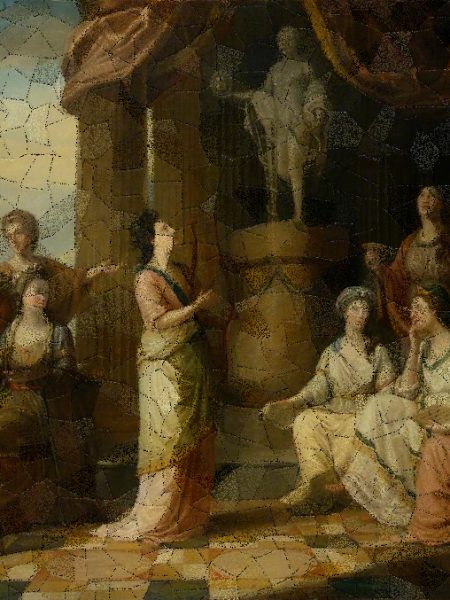Sprezzanti Rime

Portraits in the Characters of the Muses in the Temple of Apollo (1778). Richard Samuel © National Portrait Gallery, London.
MEDIA
Sprezzanti Rime Playlist
The Sprezzanti Rime project represents a crossroads in the artistic research of Vecchie Musiche, which just celebrated its first five-year anniversary last August 2023.
Some of the themes, music and characters that had characterized projects such as L’Amorosa Filosofia, Le Donne Antique and the Madrigali Ariosi gradually resurfaced in a homogeneous way during the long research process, which lasted almost two years, that led to the realization of Sprezzanti Rime.
The theme of femininity, so dear to our ensemble, once again plays a princely role: the vicissitudes of female poets of sixteenth-century Italy are recounted through their sonnets, octaves and third rhymes, set to music by contemporary artists.
Great women of the sixteenth century, such as Vittoria Colonna (1492-1547), Gaspara Stampa (1523-1554), Laura Terracina (1519-c. 1577) and Tarquinia Molza, the absolute protagonist of our project L’Amorosa Filosofia, will accompany us, with their art and sensibility, in an imaginary querelle des sexes: a battle of rhetoric between women and men in the sixteenth century.
The peculiar perspective of these women poets presents us with a more complete view of their world, too often dominated by a male-dominated society that put arms, honor and virility first, virtues emblematically projected in the figure of the mercenary captain and virtuous singer Giulio Cesare Brancaccio (1515-1586).
A worldview in which men and women live in harmony and mutual respect is advocated by scholars such as Francesco Patrizi, Alessandro Piccolomini, Lucrezia Marinella, and Ludovico Ariosto.
In their texts, which can be considered proto-feminist, the Macist view, which considers women inferior to men, is abandoned in favor of a model in which the two sexes complement each other, achieving eutrapelia, that is, the balance of opposites described in the utopian worlds of Thomas Campanella’s The City of the Sun and Margaret Cavendish’s The Blazing World.
We have chosen not to make public the names of the composers who set these “sprezzanti” verses to music. The reason for this choice is twofold: the first is to enhance the poet’s contribution to the madrigal genre, confirming that it is nothing more than an aural representation of the collective declamation of a text.
The second reason, much more insidious for the listener, is that one of the madrigals is a forgery composed especially for this concert. Will you be able to recognize it and appreciate its artistic value regardless of its “authenticity”?
PERFORMERS
Nicholas Cornia (artistic director, bass)
Maria Eichler (alto)
Andrea Gavagnin (contratenor)
Thomas Langlois (lute)
Leander Van Gijsegem (tenor)
Lidwien Van Winckel (soprano)

